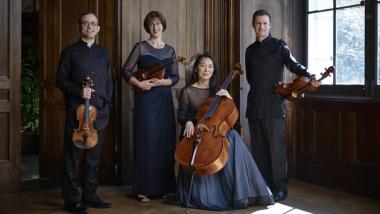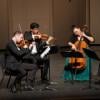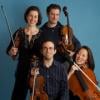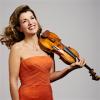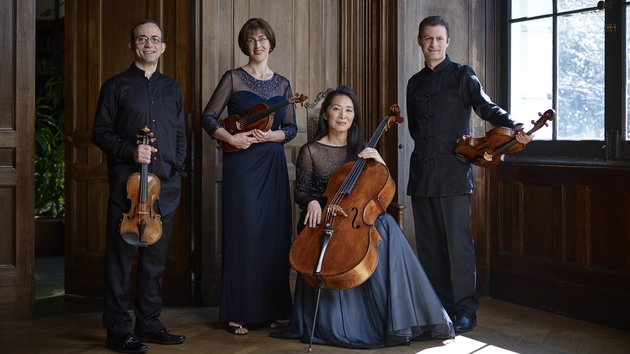
Classical violinists are known for their technical quirks, but no quirk is more obvious than Mark Steinberg’s violin position, which begins at the chin and slopes downward to the floor, like a ski jump. Instead of holding his left elbow up in the air, he plants that critical juncture firmly in his abdomen and lets his fingers fend for themselves.
From a technical standpoint, Steinberg still hits all the right notes, and his bowing seems unaffected by its subterranean exploits. But from an acoustic standpoint, his sound is often muted because his f-holes are so low. He blends well with his ensemble, the Brentano String Quartet, but he rarely soars above them.
These acoustic peculiarities were on full display at the Brentano’s Sunday concert in the Green Music Center’s Weill Hall. For the highly emotive and densely scored works in the first half — Antonin Dvořák’s Miniatures and Bela Bartók’s Second Quartet — Steinberg’s muted sound meshed perfectly with the rest of the ensemble, allowing the lower instruments to come forward and take the lead. But for the considerably lighter second half — Felix Mendelssohn’s Quartet No. 3, Op. 44 — the razzle-dazzle in the upper registers was notably lacking.
The concert began not with a quartet, but with the Dvořák Miniatures trio for two violins and viola. Steinberg, second violinist Serena Canin, and violist Misha Amory played the trio standing, adding to its charm. Although the trio is not technically demanding, the lyricism is beyond compare, particularly in the haunting elegy that draws the work to a close.
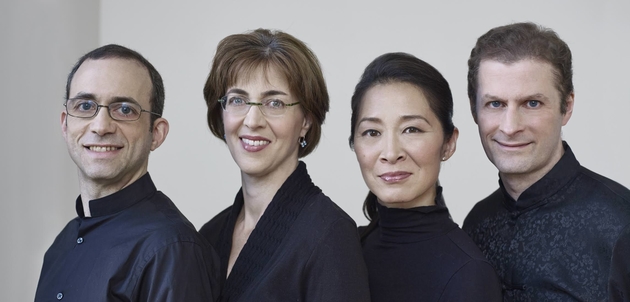
Steinberg led the trio gracefully, rarely looking at his score. In the rollicking second movement, a cavatina, he looked for all the world like a country fiddler leading a sprightly dance in a village square. The subsequent movement, an Allegro romance, floated on a cloud of perfectly blended pianissimos. The high point arrived in the concluding Elegy, where Steinberg played the haunting lament over rock-solid sustained notes from Canin and Amory. The texture was limpid, transparent, and ultimately transcendent.
Four chairs appeared, and with them cellist Nina Lee, who intoned the first note of Bartók’s Second Quartet, one of the masterpieces of the repertory. The ensemble seemed to flow as one as they eased their way into the eerie “night music” motive: a rising triplet that stops one note short of an octave, drops by a half-note, and descends by a fourth. The players handed this five-note motive from one instrument to another throughout the first movement, bringing more intensity and meaning with each reiteration. The underlying rhythmic drive was unrelenting, and the group seemed to breathe as one. The unison section near the end was fabulous.
The Brentanos began the second movement at a furious tempo and never let up, except for some impeccable ritards that quickly accelerated back to top speed. The tight ensemble was nowhere more evident than in the Presto pianissimo section, where the players’ heads bobbed up and down in unison. It was hard to imagine that the intensity could be sustained, but the slow buildup of the Lento third movement proved just as riveting, especially the call-and-response between the violins and the lower strings. This was music-making of the highest order.
After the magisterial first half, the choice of a relatively lightweight Mendelssohn quartet seemed a little odd. Granted, Bartók is a hard act to follow, but better options are available. Adding to the mismatch was Steinberg’s muted sound, which was often buried in the onslaught of running notes from the other players.
Beyond the obvious technical aspects, the challenge with this and other Mendelssohn quartets is to uncover the emotion hidden behind their somewhat mechanical confines. The Brentano succeeded to a degree, particularly in the Scherzo, but Mendelssohn’s repetitive tropes proved a significant barrier to musical breakthroughs. Nonetheless, it was delightful to hear the quartet playing with such élan, and with superb intonation and faultless rhythm. Perhaps next time the Brentano could open with the Mendelssohn and proceed to the Dvořák and Bartók.

